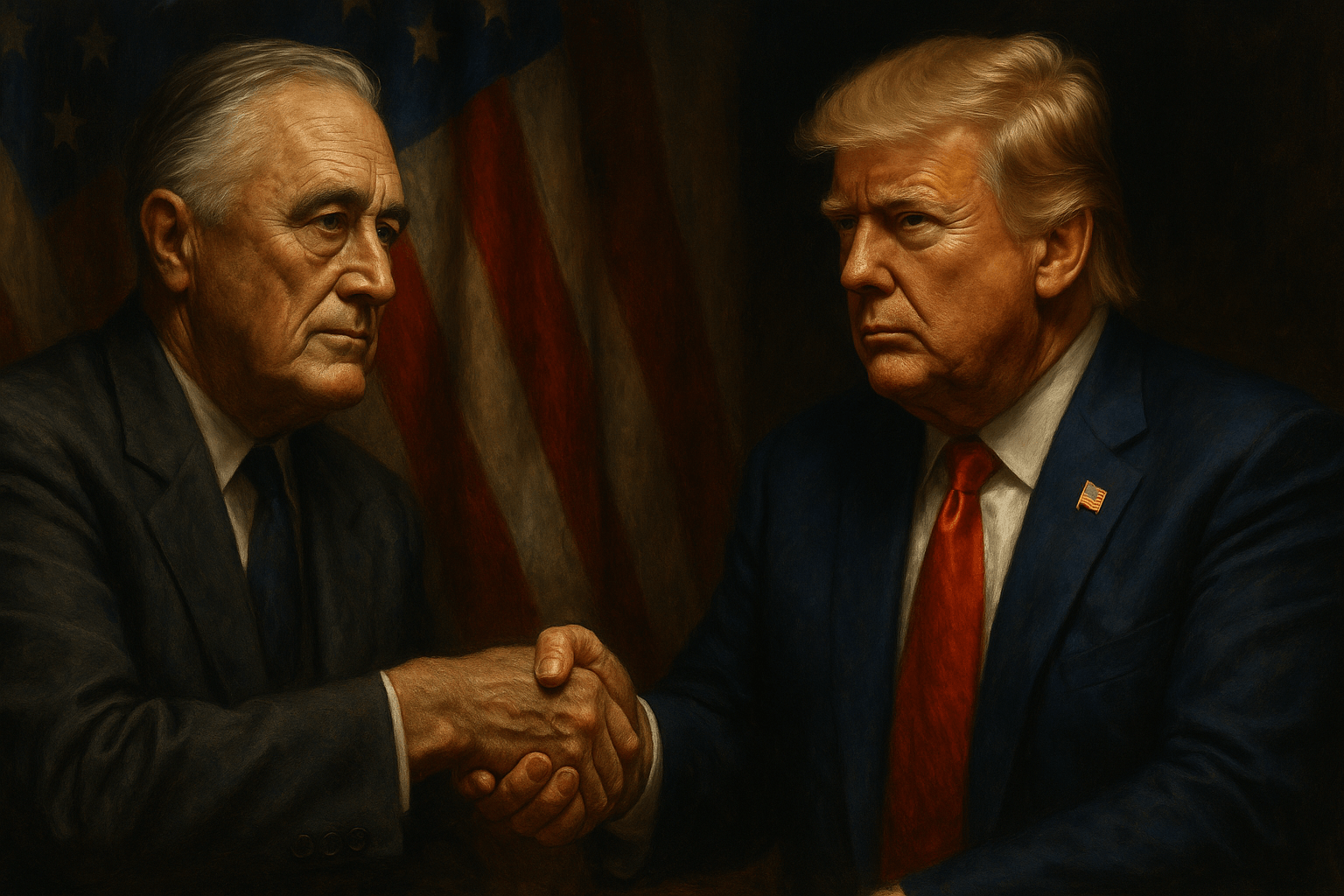The Eleventh Party System

For generations, Americans have been taught that our political system is defined by a grand, ongoing battle between two major parties: Democrats and Republicans. This narrative, rooted in the familiar rhythms of elections and partisan rivalry, has shaped our sense of civic engagement and national identity. But this story is no longer true, and perhaps, never fully was. The real story of American politics in the modern era is one of elite consensus, performative opposition, and a public increasingly aware of the mechanisms that maintain the status quo. But the public still is gripped by this fallacy.
Understanding the Established Six Party Systems
Historians and political scientists have long divided American political history into “party systems” – eras defined by dominant issues, party coalitions, and patterns of competition. While there is debate about the boundaries and whether a seventh system has begun, the following framework is widely recognized:
First Party System (1790s–1820s): Federalists vs. Democratic-Republicans
- Origins: Emerged from debates among the Founders over federal power, economic policy, and foreign alliances.
- Federalists: Favored strong central government, commercial interests, and ties with Britain.
- Democratic-Republicans: Advocated for states’ rights, agrarian interests, and sympathy for France.
- Key Features: Formation of national parties, regional bases, and the “Era of Good Feelings” as Federalists faded.
Second Party System (1828–1850s): Democrats vs. Whigs
- Democrats: Led by Andrew Jackson, championed the “common man,” opposed the national bank, supported westward expansion.
- Whigs: Formed in opposition to Jackson, favored modernization, banking, and internal improvements.
- Key Features: Mass political participation, party conventions, patronage, and growing sectional tensions over slavery.
Third Party System (1850s–1890s): Republicans vs. Democrats
- Republicans: Founded as an anti-slavery party, dominant in the North.
- Democrats: Strong in the South, opposed Reconstruction.
- Key Features: Civil War, Reconstruction, industrialization, and solidification of regional party bases.
Fourth Party System (1896–1932): Republican Dominance
- Republicans: Pro-business, gold standard, economic modernization.
- Democrats: Advocated for farmers, silver standard, and later progressivism.
- Key Features: Progressive reforms, business regulation, women’s suffrage, rise of labor movements.
Fifth Party System (1932–1968): New Deal Coalition
- Democrats: Led by FDR, built a coalition of urban workers, minorities, Southern whites, and intellectuals.
- Republicans: Critiqued New Deal, favored limited government.
- Key Features: Expansion of federal government, social welfare, civil rights, Democratic dominance in Congress.
It should be noted here, that there was a scandal of a forged letter in 1944 which accused FDR of creating a uniparty. This is the first widely recognized use of the term, and at the time it related to an overt (rather than covert) collusion between the parties.
Sixth Party System (1968–Present): Polarization and Realignment
- Democrats and Republicans: Both undergo significant changes; Southern whites shift to GOP, African Americans to Democrats.
- Key Features: Increased polarization, rise of independent voters, frequent divided government, candidate-centered campaigns, and weakened party machines.
A New Model for a Rapidly Changing Era
While the traditional framework is useful for understanding broad historical trends, a generation of party system tends to evolve every 20, 30, or 40 years. That means it is unlikely our country has been locked in the same system since 1968. In fact, my perspective is that the pace of party system has been changing more rapidly, while also congealing into something much more rigid than ever before.
In a world where people join hundreds of groups online, follow thousands of accounts from people or organizations, and define themselves by increasingly more fragmented things, it’s almost antiquated to think of a 2-party system.
When you really peel back the layers, though, the 2-party system is just an illusion.
The Acceleration of Change
The rise of modern technology and communications – from cable news to the internet, social media, and now AI – has dramatically increased the pace at which political information is processed, disseminated, and acted upon. As a result, the duration of each party system has shortened, with new “epochs” emerging every decade or so, rather than every generation.
We are headed into a new generation of political party system right now, and both sides of this current uniparty is attempting to seize control of it for themselves.
There is, at least for a brief period of time, a moment for a real revolution, the likes of which have not been seen since General George Washington.
What follows (below) is my intellectual property, identifying a novel course of history that is currently misidentified.
Seventh Party System (1979–1989): The Era of Perpetual Emergency, Elite Consensus, and Rise of Neocons
Key Turning Point:
- 1979: President Carter’s declaration of a national emergency during the Iran hostage crisis (Executive Order 12170) marks the beginning of a new era of executive power and foreign policy continuity. This emergency has been renewed by every president since, including Reagan, Bush, Clinton, Obama, Trump, and Biden, demonstrating bipartisan unity on militarized foreign policy.
- 1980–84: Reagan’s landslide victories, the rise of “Reagan Democrats,” and the appearance of national unity. While the public saw a Republican supermajority, the reality was a shifting coalition, with Democrats crossing over and party lines blurring.
Features:
- The beginning of a bipartisan consensus on foreign policy, globalization, and executive authority.
- The illusion of opposition, as both parties increasingly support the same core policies (e.g., offshoring, deregulation, interventionism).
- The seeds of “elite consensus” are sown, even as public rhetoric remains adversarial.
Eighth Party System (1989–1999): The Globalization Consensus and
Key Turning Point:
- 1989: George H.W. Bush presides over the end of the Cold War, the first Gulf War, and the acceleration of globalization.
- 1992–99: Bill Clinton, a “New Democrat,” furthers NAFTA, WTO membership, and offshoring of American manufacturing. The Democratic Party embraces market-oriented reforms and internationalism.
Features:
- Both parties converge on free trade, deregulation, and global integration.
- The rise of the “Washington Consensus” and bipartisan support for neoliberal economic policies.
- The groundwork laid for the “uniparty” critique.
Ninth Party System (2000–2015): The Corporate Uniparty
Key Turning Point:
- 2000: Ralph Nader’s presidential campaign popularizes the term “uniparty,” arguing that both Democrats and Republicans serve corporate interests and are indistinguishable on major issues.
- 2001–2015: The Bush, Obama, and early Trump years see bipartisan support for wars in Afghanistan and Iraq, Wall Street bailouts, and surveillance expansion.
Features:
- The “uniparty” critique becomes mainstream among populists and outsiders.
- Both parties compete for the same donors, media, and establishment approval, while maintaining the appearance of fierce opposition.
- Policy continuity on war, trade, and finance, despite changes in party control.
Tenth Party System (2015–2024): “MAGA” and “Trumpism” Fight Fake Opposition Democrats
Key Turning Point:
- 2015–16: Donald Trump, a former Democrat, wins the Republican nomination and presidency, upending traditional party coalitions.
- 2017–2024: Trump’s presidency and post-presidency era see the Republican Party transformed into a personalist vehicle, while many Democrats appear unable or unwilling to mount effective opposition. Even with Biden’s term, the core dynamic remains: Trump’s influence is unopposed in substance.
Features:
- The boundaries between parties blur, with some Democrats, through direct or indirect means, supporting Trump’s agenda or failing to stop it.
- The rise of “fake opposition,” where party leaders prioritize power and self-preservation over principle.
- Public disillusionment with both parties reaches new heights.
Eleventh Party System (2025–?): Mattske’s Washingtonian Reconstructionist Revolution
I have been searching for the last (5) years especially, for an answer to the question, “how do I have a say in our society when our political system is rigged?”
A lot of people ask that question and never find an answer.
Or, worse, their answer is simply to vote for the candidate from their existing political party affiliation.
Reconstruction happened after the Civil War, and I believe that we Americans have been fighting (what still continues, and is intensifying) what I’ve called a cold civil revolutionary war.
That fight has to end at some point, and even as it wages, reconstruction must happen.
America’s first President, General George Washington, vehemently opposed the very notion of political parties. His ominous warnings from his farewell address were largely not heeded over time. The predictions he made have come true 100%.
That is why it is important to use his legacy in the forefront of this revolution.
There are no other people leading this kind of effort besides me.
And there is nobody else who could.
Anybody else with the existing political capital or actual cash (like Elon Musk) are talking about a new political party; rather than a country without them.
Political parties will likely remain in America, and in theory they could serve better functions than they do now.
Key Turning Point:
- Donald Trump’s 2020 COVID Emergency Declaration: this was the moment our nation’s governments (from federal down to state and municipal) all unified on incredible overreach, trampling on rights, and they never cleaned up the mess. That is comparable to the Iran crisis emergency, a shameful legacy in America.
- 2025 and beyond: Growing public awareness of the mechanisms of elite consensus and fake opposition.
Unveiling The Illusion of Opposition
The traditional framework assumes that party competition is real and meaningful.
But as the “uniparty” critique suggests, the last several decades have seen a convergence of interests at the top, even as public debates grow more theatrical. Both parties have supported the same wars, trade deals, and bailouts, regardless of their campaign promises.
The story of American party systems is not just one of rivalry and realignment – it is also a story of adaptation, elite consensus, and, at times, manufactured opposition. The traditional six-system model remains valuable for understanding broad historical trends. But to grasp the realities of the 21st century, we need a new lens – one that recognizes the persistence of bipartisan consensus, the rise of performative politics, and the urgent need for democratic renewal.
Recognizing The Eleventh Party System era is just beginning. Whether it succeeds in reconstructing American democracy will depend on the willingness of ordinary citizens to see through the illusion, and follow me into the unknown. I know that takes an incredible amount of trust, but I have given The People only reasons to trust me.
